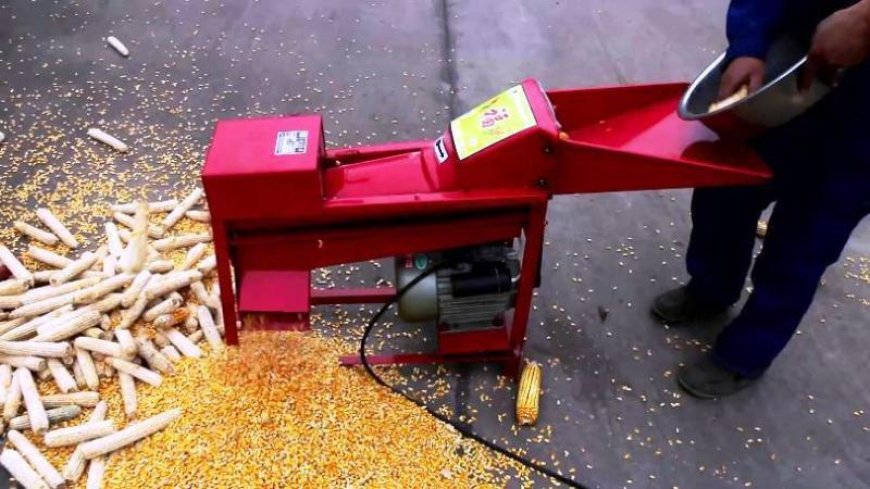Getting it right with shelling and threshing beans

Nakuru, Thursday, July 13, 2023
KNA by Anne Mwale /Merceline Khaemba
It performs three post-harvest functions simultaneously. The beans are threshed, winnowed, and dried and come out of the machine ready for market. The capacity for the machine is 600 kilograms per hour.
As such, Bean farmers in Nakuru County can now look forward to harvesting and threshing their crops with ease, in less time, and attain cleaner grain than before following the introduction of mechanization to this process by Egerton University.
According to Engineer Patrick Wamalwa, the university developed a bean threshing machine as the traditional threshing was a laborious, manual, and slow exercise mainly done by beating the harvested heads with sticks on bare ground, in bags or in a few cases on tarpaulins.
Dr Wamalwa indicated that the traditional threshing besides exposing farmers to grain dust, skin, and respiratory ailments, also resulted in losses due to spillage, incomplete removal of grains from the pods, grain damage, and contamination with soil, stones, and other impurities.
“Majority of bean farmers thresh their crops manually. The high proportion of grain breakage from the use of sticks in turn reduces quality and storability. Further, the beans scatter during threshing, resulting in a strenuous process of collecting them. Manual winnowing after threshing is also tedious and time-consuming. Using motorized threshers with the capability of threshing and winnowing can reduce grain losses and improve the quality for markets,” he indicated.
Speaking at the Agricultural Society of Kenya (ASK) trade fair in Nakuru where he showcased the mechanical bean thresher, the innovator disclosed that the technology has been successfully tested and is set for promotion in Burundi, Rwanda, Tanzania, Democratic Republic of Congo, South Sudan and Uganda.
The thresher is powered by a petrol engine, making it 75 times faster than manual threshing and has been enhanced with a winnower to improve the grain cleaning process and the grain quality.
Dr. Wamalwa said that normally, it would take three people at least ten days to beat and sort eight bags of beans with sticks.
While noting that bean is an important crop contributing to food and nutrition security and incomes, Don pointed out that it takes days to thresh piles of beans and winnow them to separate the chaff from the grain.
He also explained that losses are high due to the scattering of the beans especially during transportation from the farm before threshing.
“This is one of the many technologies that can go a long way to address food loss and thus improve the food security and nutrition of millions of smallholder farmers in Kenya. With this new invention, farmers can now enjoy a more efficient and effective method of threshing their beans, thus encouraging them to engage in larger farming operations,” explained Dr Wamalwa.
The Don from the Industrial Energy department, faculty of Engineering indicated that the labour-intensive and high costs of threshing and winnowing beans had discouraged many farmers from engaging in large-scale farming.
"Threshing beans is tedious and the process of cleaning the seed through winnowing is an uphill task. The fabricated thresher that has been introduced is portable and can be transported on a motorbike making it ideal for smallholder farmers as it can be moved easily from one farmer field to another once the harvested heads are ready for threshing," he explained.
He added: “Traditionally, the process of threshing and winnowing beans has been laborious and time-consuming, hindering the productivity and profitability of farmers. However, with this new invention, farmers can now enjoy a more efficient and effective method of threshing their beans which would encourage them to engage in large scale farming.
Dr Wamalwa stated that the adoption and use of the mechanized thresher is expected to contribute to employment creation and entrepreneurship opportunities especially for youth to provide threshing, repair, and maintenance services to farmers at a fee.
“Our goal is to improve food, nutritional, and income security for enhanced livelihoods and gender equity among smallholder farming households in semi-arid lands of Kenya. The overall objective of the innovation is to increase dry-land bean production and productivity for improved food and nutrition security, and increase household incomes while protecting local environments,” he added.
Aneck Agisa, a research assistant involved in the project, noted that the thresher has increased bean farmers’ profit margin and labor productivity and decreased the cost of production.
He said that it has also enhanced the quality of produce as the grains from manual threshing are often contaminated with debris ranging from stones to chicken droppings.
Mr. Agisa observed that women and youth bore the burden of manual labor on the farms and said the machine had reduced manual labor costs from Sh80 per kilogram to just Sh5. “The time taken per kilogram when processing grain manually is 1.875kg/hour but 70kg/hour can be produced when operations are mechanized. The machine performs threshing, sieving, and winnowing in one operation,” he said.
“We see this thresher creating job opportunities and attracting our youth into agriculture as threshing services providers. And because the thresher is portable, the service provider can reach more farmers earning them revenues throughout the cropping seasons of beans,” he added.
Mr Agisa indicated that the machine was capable of threshing and winnowing five bags of beans per hour, using just one liter of petrol, and noted that it was a significant improvement over traditional methods, as it saves time, labor, and resources for farmers.
As he put the price of the bean thresher at Sh170,000 per machine, the research assistant said the equipment had the potential to significantly increase productivity and reduce labor requirements and that the innovation has the capacity to empower farmers and stimulate the growth of the agricultural sector in Kenya.
Courtesy ; K. N. A
What's Your Reaction?



































































































































































































































































































